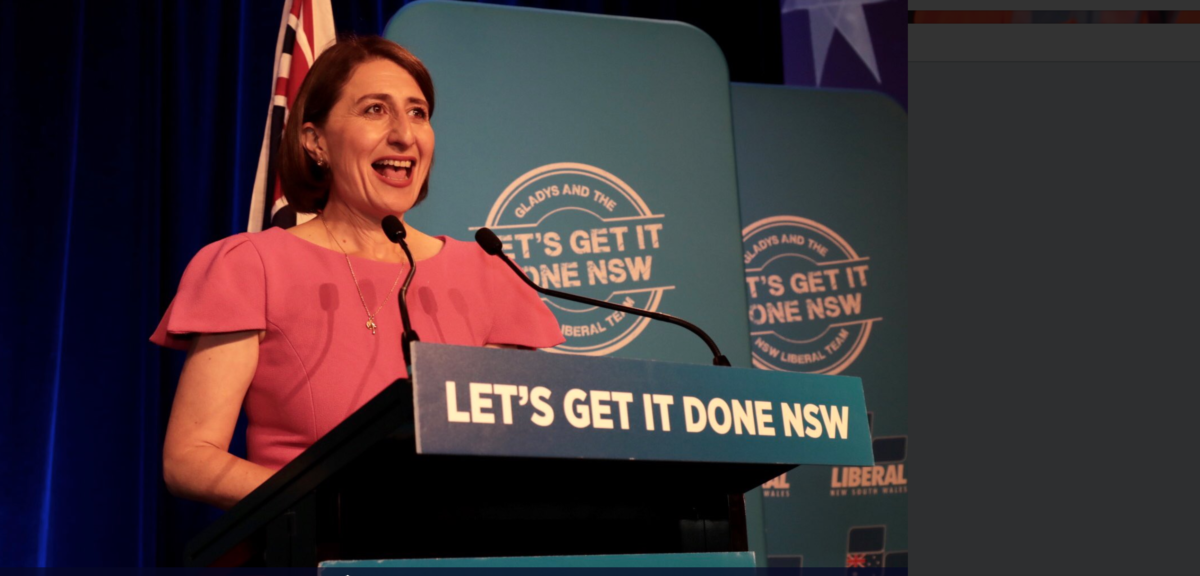The release of the NSW Government’s Climate Change Policy Framework and its 2050 net-zero emissions target begins the fulfilment of one of the NSW Liberals & Nationals key re-election campaign promises – to set a target that was firm beyond the previously ‘aspirational’.
In parliamentary questions on the 2019-2020 budget estimates last week Premier Berejiklian was pushed by upper house Greens MP David Shoebridge on just what the Government meant by their ‘aspirational’ 2050 goal. “Premier, you say you have a proud record, but State greenhouse gas emissions have gone up every year under your Government. At best, you have an aspirational goal for net zero emissions by 2050. What does an ‘aspirational goal’ mean, and why isn’t a concrete and real goal?” asked Shoebridge, who continued, “But what does ‘aspirational’ mean? Does that mean you can miss it?”
At this pressing the Premier responded: “I am happy for you to delete the word ‘aspirational’. That is our target and it is right in line with the Paris Agreement.”
The Framework commits the state to an aim of ensuring the wellbeing of NSW in the context of a changing climate through policy to address climate change and maximise economic, social and environmental stability. These aims are set down in two aspirational long-term objectives, to achieve net-zero emissions by 2050 and to make NSW more resilient to a changing climate.
To achieve its aspirations, the NSW Government has outlined several policy directions. First and foremost, the NSW Government wants to create “a certain investment environment by working with the commonwealth to manage transition”, which is to say, the fostering of renewable energies like solar PV should see investment prioritisation. However, part and parcel of this incentivisation of renewable industry is the necessity of downward pressure on household and business energy bills.
It is logically incoherent that the transition to renewable energies should not result in lower energy bills, but consumers know from experience that energy companies are not restrained by anything as unprofitable as logic; it is therefore a necessary policy to ensure “downward pressure” on prices because the spirit necessary for the transition must come from both the consumers and the generators.
Prior to the 2019 NSW State Election then Minister for Energy Don Harwin promised his party believed “in practical action on climate change and our environment in partnership with the private sector and communities across NSW to deliver our goal of achieving net-zero emissions by 2050.”
On the topic of NSW’s emissions target the Minister for Energy and the Environment Matt Kean has spoken of taking decisive and responsible action on climate change. “Climate change is already having an impact on our State and the public expects us to take responsible action to address it,” said Kean, “our government was elected on a policy of net zero emissions by 2050 and we are working towards delivering that.”
Minister Kean also noted that NSW has great potential in the renewable industry, particularly solar PV. NSW is home to “Australian scientists and global leaders in solar efficiency and there is no reason why we can’t be the Silicon Valley of clean technology.”
Now, as “aspirational” as these goals are, and one can quite easily relativise such goals with a quick look across the Victorian or South Australian border, this Climate Policy Framework is nothing more than that, a framework. The Framework’s “Implementation” doesn’t go so far as to implement policy but rather, the investigation and development of potential policies, benchmark values, strategic plans and emissions saving techniques. Still, it’s a start.
The key aspect is the clear and unequivocal target of 2050, something to peg NSW policy to going forward.
This content is protected by copyright and may not be reused. If you want to cooperate with us and would like to reuse some of our content, please contact: editors@pv-magazine.com.









By submitting this form you agree to pv magazine using your data for the purposes of publishing your comment.
Your personal data will only be disclosed or otherwise transmitted to third parties for the purposes of spam filtering or if this is necessary for technical maintenance of the website. Any other transfer to third parties will not take place unless this is justified on the basis of applicable data protection regulations or if pv magazine is legally obliged to do so.
You may revoke this consent at any time with effect for the future, in which case your personal data will be deleted immediately. Otherwise, your data will be deleted if pv magazine has processed your request or the purpose of data storage is fulfilled.
Further information on data privacy can be found in our Data Protection Policy.